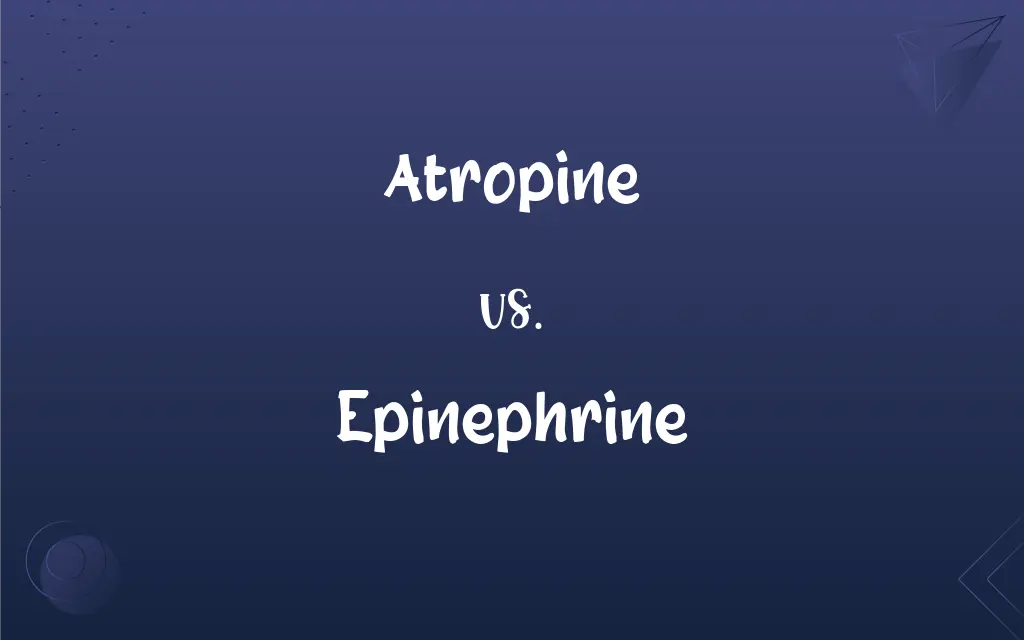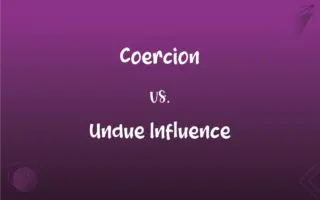Atropine vs. Epinephrine: What's the Difference?
Edited by Harlon Moss || By Janet White || Published on March 12, 2024
Atropine is an antimuscarinic agent used to treat bradycardia and as an antidote for certain poisonings, while epinephrine is an adrenergic agonist used for anaphylaxis and cardiac arrest.

Key Differences
Atropine works by blocking acetylcholine receptors (antimuscarinic), reducing parasympathetic activity. Epinephrine activates adrenergic receptors, enhancing sympathetic activity.
Atropine is used for bradycardia (slow heart rate) and as an antidote for organophosphate poisoning. Epinephrine is a first-line treatment for anaphylactic shock and is also used in cardiac arrest.
Atropine increases heart rate and reduces secretions. Epinephrine causes vasoconstriction, increases heart rate, and opens airways.
Atropine can be administered intravenously, intramuscularly, or as eye drops. Epinephrine is often administered intravenously or via intramuscular injection in emergencies.
Atropine may cause dry mouth, blurred vision, and urinary retention. Epinephrine can cause palpitations, tremors, and anxiety.
ADVERTISEMENT
Comparison Chart
Mechanism of Action
Antimuscarinic (blocks acetylcholine)
Adrenergic agonist (activates adrenergic receptors)
Primary Uses
Treating bradycardia, antidote for poisoning
Anaphylaxis, cardiac arrest
Physiological Effects
Increases heart rate, reduces secretions
Vasoconstriction, increases heart rate, bronchodilation
Administration
IV, IM, eye drops
IV, IM
Common Side Effects
Dry mouth, blurred vision, urinary retention
Palpitations, tremors, anxiety
ADVERTISEMENT
Atropine and Epinephrine Definitions
Atropine
Antimuscarinic Agent.
As an antimuscarinic, atropine blocks acetylcholine receptors.
Epinephrine
Bronchodilator.
Epinephrine helps open airways in asthma attacks.
Atropine
Ophthalmic Use.
Atropine drops are used to dilate pupils for eye examinations.
Epinephrine
Anaphylaxis Treatment.
Epinephrine is the first-line treatment for severe allergic reactions.
Atropine
Bradycardia Treatment.
Atropine is administered to increase heart rate in bradycardia.
Epinephrine
Adrenergic Agonist.
Epinephrine acts as an adrenergic agonist to combat shock.
Atropine
Antidote for Poisoning.
Atropine serves as an antidote for organophosphate poisoning.
Epinephrine
Cardiac Arrest Management.
Epinephrine is used in cardiac arrest to stimulate the heart.
Atropine
Parasympathetic Inhibitor.
Atropine inhibits parasympathetic nerve impulses.
Epinephrine
Vasoconstrictor.
Epinephrine causes vasoconstriction to elevate blood pressure.
Atropine
A poisonous, bitter, crystalline alkaloid, C17H23NO3, obtained from belladonna and other related plants. It is used to dilate the pupils of the eyes and as an antispasmodic.
Epinephrine
A hormone secreted by the adrenal medulla that is released into the bloodstream in response to physical or mental stress, as from fear or injury. It initiates many bodily responses, including the stimulation of heart action and an increase in blood pressure, metabolic rate, and blood glucose concentration. Also called adrenaline.
Atropine
An alkaloid extracted from the plant deadly nightshade (Atropa belladonna) and other sources, such as the seeds of the thorn-apple. Though overdoses would be fatal it is used as a drug in medicine for its paralytic effects (e.g. in surgery to relax muscles, in dentistry to dry the mouth, in ophthalmology to dilate the pupils).
Epinephrine
A white to brownish crystalline compound, C9H13NO3, isolated from the adrenal glands of certain mammals or synthesized and used in medicine as a heart stimulant, vasoconstrictor, and bronchial relaxant.
Atropine
A poisonous, white, crystallizable alkaloid, extracted from the Atropa belladonna, or deadly nightshade, and the Datura Stramonium, or thorn apple. It is remarkable for its power in dilating the pupil of the eye. Called also daturine.
Epinephrine
(medicine) A catecholamine hormone and neurotransmitter; as a hormone, secreted by the adrenal gland in response to stress (when it stimulates the autonomic nervous system); as a neurotransmitter, synthesized from norepinephrine. It is also used as a medication.
Atropine
A poisonous crystalline alkaloid extracted from the nightshade family; used as an antispasmodic and to dilate the eye pupil; also administered in large amounts as an antidote for organophosphate nerve agents or organophosphate insecticides
Epinephrine
A catecholamine secreted by the adrenal medulla in response to stress (trade name Adrenalin); stimulates autonomic nerve action
FAQs
What is epinephrine used for?
Treating anaphylaxis and in cardiac arrest management.
How does atropine work?
It blocks acetylcholine receptors, reducing parasympathetic activity.
What is the mechanism of epinephrine?
It activates adrenergic receptors, enhancing sympathetic nervous system activity.
Can atropine increase heart rate?
Yes, it's used to treat low heart rate conditions.
What are the side effects of epinephrine?
Common side effects include palpitations, tremors, and anxiety.
What is atropine used for?
Treating bradycardia and as an antidote for certain poisonings.
Are there side effects to atropine?
Yes, including dry mouth, blurred vision, and urinary retention.
Is atropine used in eye exams?
Yes, eye drops are used to dilate the pupils.
Does epinephrine increase blood pressure?
Yes, it causes vasoconstriction, which can increase blood pressure.
What are the storage requirements for atropine?
Store in a cool, dry place away from light.
How is epinephrine administered during emergencies?
Typically, it's given intravenously or via intramuscular injection.
Are these drugs over-the-counter?
No, both are prescription medications.
How is atropine administered?
It can be given intravenously, intramuscularly, or as eye drops.
Is epinephrine effective in cardiac arrest?
Yes, it's a key drug in cardiac arrest protocols.
Is epinephrine safe for everyone?
It's generally safe in emergencies, but a doctor should assess individual risks.
How should epinephrine be stored?
It should be stored at room temperature, away from light and extreme heat.
Can epinephrine be used for asthma?
Yes, it acts as a bronchodilator in asthma attacks.
Can atropine be used for organophosphate poisoning?
Yes, it's an effective antidote.
What is the difference in action between atropine and epinephrine?
Atropine inhibits parasympathetic activity, while epinephrine stimulates sympathetic activity.
Can atropine treat allergies?
No, it's not used for allergic reactions.
About Author
Written by
Janet WhiteJanet White has been an esteemed writer and blogger for Difference Wiki. Holding a Master's degree in Science and Medical Journalism from the prestigious Boston University, she has consistently demonstrated her expertise and passion for her field. When she's not immersed in her work, Janet relishes her time exercising, delving into a good book, and cherishing moments with friends and family.
Edited by
Harlon MossHarlon is a seasoned quality moderator and accomplished content writer for Difference Wiki. An alumnus of the prestigious University of California, he earned his degree in Computer Science. Leveraging his academic background, Harlon brings a meticulous and informed perspective to his work, ensuring content accuracy and excellence.































































